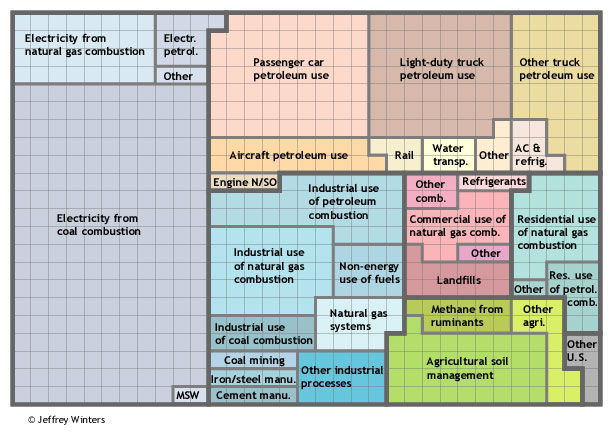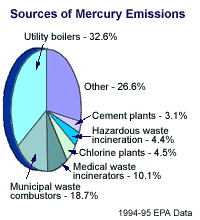Follow up on the previous post
There seems to be widespread acceptance of the facts of where we get our energy, and little else.
I should change the phrasing perhaps on intractable problems. This is what John Holdren, outgoing president of AAAS, said in Energy Innovation Imperative:
Global climate change is increasingly recognized as both the most dangerous and the most intractable of all of energy’s environmental impacts”indeed, the most dangerous and intractable of all of civilization’s environmental impacts, period.Distortions of this envelope [the atmosphere] of the magnitude that are underway and in prospect are likely to so badly disrupt the environmental conditions innovations and processes influenced by climate as to adversely affect every dimension of human well-being that is tied to the environment, including:
__ the productivity of farms, forests, and fisheries;
__ the geography of disease;
__ the prevalence of oppressive heat and humidity;
__ the damages to be expected from storms, floods, and wildfires;
__ the property losses to be expected from sea-level rise;
__ the expenditures that must be made on engineered environments (e.g., dams, dikes, air-conditioned spaces); and
__ the distribution and abundance of valued species as well as pests.
It is becoming clear, nonetheless, that the current level of anthropogenic interference is dangerous.

John Holdren
I am struck when I read Scot’s comments that he believes that 1) somehow we can eliminate nuclear power, and that 2) this will help protect us from nuclear war.
Actually, the use of nuclear power is expected to expand rapidly over the next half century. China intends to provide about one half wedge of nuclear power just by itself, building nuclear power capacity almost as great as exists today worldwide. From Scandinavia to the UK to South Africa to the US to Japan, new nuclear power plants are proposed.
It is fortunate then that getting rid of nuclear power does not appear to be a major mechanism for eliminating nuclear weapons.
John Holdren in his plenary address to the February meeting of the American Association for the Advancement of Science lists the two methods that people in nuclear weapons policy emphasize:
• strengthen and adequately fund the International Atomic Energy Agency, and
• zero out the nuclear weapons of all nuclear weapons states.
After all, we agree to the second it the Non-Proliferation Treaty (NPT), to:
pursue negotiations in good faith on effective measures relating to the cessation of the nuclear arms race at an early date and to nuclear disarmament…
unfortunately, without a timetable.
I agree with Scot and people pretty much everywhere in advocating that the US and Russia and other nuclear weapons states have a serious discussion before the next follow-up talks on the NPT.

2005 Campaign to Strengthen the NPT According to Arms Control Association,
Unfortunately, the once-every-five-years meeting closed without any agreed assessment or plan to bolster the treaty.
Second, Scot proposes that nuclear power has been important to the spread of nuclear weapons. Jon addresses this twice. I did an entire series on weapons and power, go to Nuclear Power in a Warming World for the links. See especially Nuclear Power and the Weapons Threat and Nuclear Proliferation– International Treaties.
Scot says,
Any nation that has the infrastructure to support civilian nuclear power plants (including the ability to obtain and enrich uranium, possibly the ability to reprocess spent fuel to obtain plutonium, trained nuclear scientists and engineers, and an industrial base to support the above) can produce nuclear weapons in a relatively short period of time, if it chooses to do so.
Of these, the most important is industrial base, although both the USSR and China developed nuclear weapons without a strong industrial base and without nuclear power.
Scot also says that the spread of nuclear power has led to greater proliferation (though the only example he gives is Iran under the cover of nuclear power claims). From the examples provided, perhaps we would be better off without nuclear medicine.
Actually, the Non-Proliferation Treaty was signed in large part because of the carrot of nuclear power (with some notable exceptions: Israel, India and Pakistan). The Nuclear Suppliers Group is an international system of monitoring dual-use technologies. This is the primary method of detecting clandestine weapons program. North Korea wanted civilian nuclear power from the USSR, signed the NPT to get it (the deal fell through), and thus agreed to aggressive monitoring.

Nuclear Suppliers Group
Khan of Pakistan helped spread nuclear weapons technology, but this did not depend on the use of nuclear power.
It is important to focus on nuclear weapons policies if we are to decrease the use of nuclear weapons. Focusing on nuclear power is a dead end.
Ruth points out that anti-nuclear weapons advocates Bethe and Blix were/are nuclear power proponents. NNadir points out the biggest nuclear weapons risk (we can’t uninvent them) and that the chances of war are likely to increase as we add climate refugees in large numbers. (My first interest in climate change came from the equality testimony — respecting everyone equally, including the right to life, and the peace testimony, taking away the occasions that lead to war, as climate change is likely to be a major cause of war this century.)

Hans Bethe
On a different subject, Joffan points out that increasing efficiency in cars may lead to their increased use, also see Rebound Effect from Better Mileage. Two responses: increasing efficiency may cost more than just burning the gas (if we neglect externalities not included in the price, like climate change and pollution and increased power of some nasty leaders). Hopefully we can find ways to internalize some of those externalities to encourage more than the altruistic to adopt those behaviors. Second, when increasing efficiency leads to lower costs, it may sometimes be useful to increase the cost of gasoline, electricity, whatever, to encourage reduced use.
Arthur feels that nuclear power plant catastrophes are worse than coal power plants in normal operation. I’m not sure how, as coal power produces about eight Chernobyls/year in the US, more than 100/year in China. See Relative Danger of Energy Sources. Arthur feels that we need to focus more on reducing the use of single occupancy vehicle. As someone who mostly travels by bus and train and bicycle, I would like to see many more people traveling by these methods, both because they are enjoyable and because as more use public transit, the faster it improves. However, even if ridership doubles in the US, it will be a tiny blip in the upward exponential of car use. Advocate for both, but don’t assume that we will be able to go without more efficient cars because everyone is getting on the bus.

Do we prefer travel by car or

other modes of transportation?
I’ve covered a number of Arthur’s points in previous blogs. Again, go to Nuclear Power in a Warming World for the links.






















